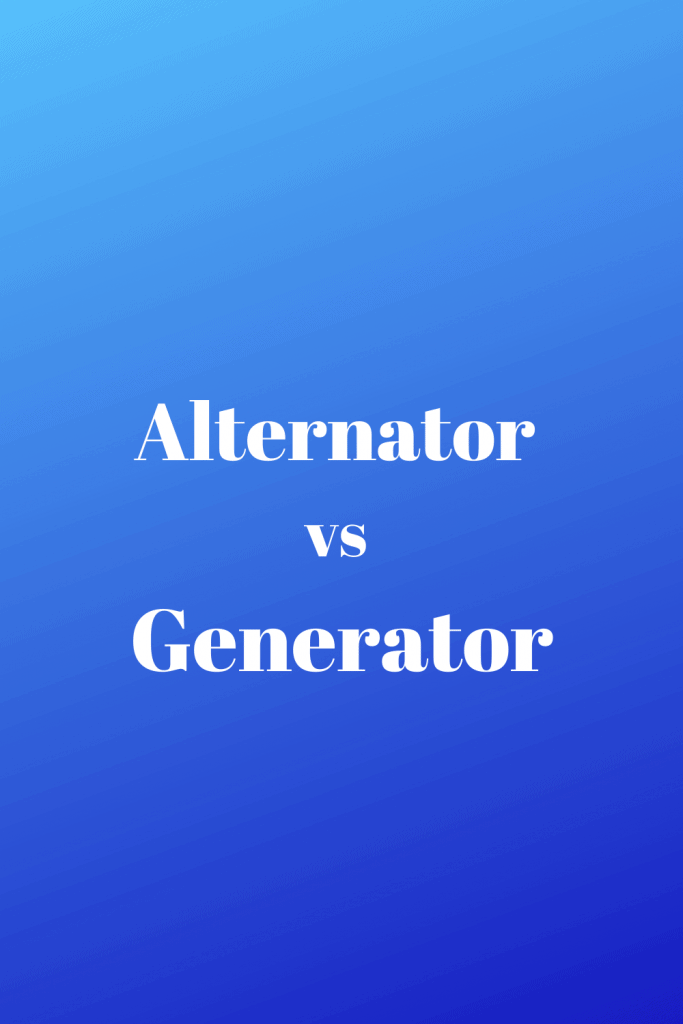Alternator vs Generator will give differences between these two machines.
Definition of alternator and generator
An Alternator
A Alternator is a gadget used to change over mechanics to exchanging current (AC).
A Generator
A generator is an electrical gadget that encourages the conversion of mechanics to rotating flow (AC) or direct flow (DC).
Alternator versus generator
From the outset, these two electrical gadgets appear to work also. However, there is a significant distinction between the generator and the generator. Peruse more to figure out how to recognize the two.
Points of interest of the alternator versus the generator

We have just exhibited that the generator is increasingly dependable and requires less upkeep.
This is the fundamental explanation behind supplanting generators with generators by and large.
Be that as it may, there is another motivation behind why generators are liked.
Even though AC power requires more control, both voltage and recurrence must be overseen (contrasted with DC voltage just), it is conceivable to control AC power all the more precisely.
With capacitors, one can deal with voltage and recurrence with exact accuracy.
The direct current must be controlled.
This implies it is conceivable to lessen the DC voltage to keep away from over-burden.
However, the inverse can’t be accomplished. You can’t expand the DC voltage if it is excessively low.
They are fundamentally the same as regarding power generation.
However, they have various abilities and applications.
From one perspective, since generators can’t give enough vitality to keep the vehicle extras running, generators are the ideal decision for powering various kinds of autos, for example, vehicles, yachts, and prepares.
By assuming a first job in the vehicle’s charging framework, the generator can likewise renew the vitality of the spent batteries.
The generator, then again, is usually utilized as an elective vitality source that powers homes and even enormous enterprises.
Furthermore, since the generator can deliver a steady yield voltage, it tends to be utilized to charge the batteries or energize the generators.
Power generation
The two of them produce electrical vitality from mechanical vitality, yet they do it in various ways.
The generator comprises four principal parts: 1) stator, 2) rotor, 3) voltage controller, and 4) diode.
Power conversion starts when the motor sends the generator pulley to the turning movement, which makes the rotor pivot rapidly.
The rotor makes an attractive exchanging field that addresses the AC to the stator.
The exchanging current of the stator keeps on streaming towards the diodes, which guides the flow.
As the present passes, the voltage controller restricts the voltage provided to the vehicle battery to abstain from cheating.
By correlation, the generator is a progressively advanced gadget and for the most part, comprises of 9 sections: 1) motor, 2) generator, 3) voltage controller, 4) control board, 5) fuel framework, 6) exhaust framework, 7) oil framework, 8) outline 9) Battery charger.
Like the generator, the generator works as per the standard of electromagnetic acceptance by Michael Faraday, which clarifies the connection between movement, attractive field, and electric flow.
When it works with coal or different types of vitality, the generator encourages conversion by driving electrical charges (found in the wires) to move to an external electrical circuit, making electric power be produced.
Generators and alternators are two gadgets that produce power.
The generator can be known as a sort of generator.
Albeit the two devices play out a similar capacity, they are unique in every other regard.
How to Use an Alternator As a Generator
The rotor and stator of a car alternator are made of coiled wires. This rotor produces electricity, which rotates the armature, which produces voltage throughout the device. While the armature is stationary, the magnetic field in the alternator is stationary, and it generates energy by spinning. Unlike an alternator, which uses a fixed magnetic field, a generator has a rotating armature and is vulnerable to low-voltage excitation.
An alternator has three wires. The first wire is the fattest and the shortest. It does not connect to any other generator component. It is a remote voltage-sensing wire, and connects to terminal two of a voltage regulator. The second wire is connected to the positive output of the battery, and connects to the main negative output. These connections are very important.
The other two wires are connected to the negative terminal of the alternator. A third wire is attached to the positive terminal of the battery. The second wire connects to the negative terminal of the alternator. The last wire connects to the negative terminal of the battery. This way, both the armature and the rotor are in parallel operation. The parallel operation makes the alternator a highly efficient generator.
How Do I Know If it’s the Alternator Or the Generator That is Better?
A malfunctioning alternator can cause all sorts of electrical issues. A problem with the generator can result in a faulty light. This is a common symptom of an alternator failure. When power needs increase, the generator may be unable to keep up. If the problem is the alternator, it will result in a blown fuse and no power to the lights.
While there are a variety of other warning signs to look out for, a faulty alternator can make your vehicle not start. Usually, it’s the alternator that is causing your car to have trouble. It may also result in a blown fuse. It’s important to know the difference between the two so that you can avoid expensive repairs. Fortunately, there’s an easy way to determine which problem it is. Getting a sp group bill can streamline your electric bill payment.
If you have a voltmeter, you can easily test the alternator. However, this is not the easiest method. If you have a car without a voltmeter, it’s difficult to tell if the alternator is the culprit. The best way to determine whether your alternator is failing is to turn on your radio. If you hear a whine, the alternator might be the problem.
Why Do Cars Use Alternators Instead of Generators?
Alternators are a popular alternative to generators. The mechanical energy from a fossil-fueled engine is passed through the stator windings, which convert the mechanical energy to direct current. The difference between the two is that the alternator produces three-phase AC, while a generator only produces a single-phase AC. Nevertheless, an alternator produces three times as much electrical current as a typical generator, and it is much lighter and smaller.
The difference between a generator and an alternator is the difference in voltage regulation. An alternator produces direct current, which has low ripple, while a generator produces a square-wave voltage. A high-resistance rotor coil doesn’t require a lot of current to excite, while a higher-resistance one requires more current to generate the same amount of energy.
Because the alternator has a higher resistance, it can generate power even at low RPMs. An alternator also has a smaller size than a generator, which allows it to fit in a crowded engine compartment. And since it is small, it can be easily maintained and repaired. The only real difference between a generator and alternator is that an alternator has a lower resistance.
In a nutshell, alternators produce more DC than generators do. But they are not perfect. An alternator produces DC instead of AC, which a car needs to operate. The development of solid-state electronic alternators (SSE) began in the late 1950s. These new devices used diode rectifiers to convert AC to DC more efficiently than mechanical alternators could. Unlike the earlier alternators, they were more efficient and simpler.
The difference between a generator and an alternator

Generators and alternators are devices that generate electricity. Both alternators and generators convert mechanical energy from a car engine to electrical power.
The main differences between the two can be best explained with respect to the output, structure, and efficiency.
Electromagnetic induction
Generators and alternators work through the simple process of electromagnetic induction, which involves changing the magnetic field.
Who applied to a conductive wire, produces a current. On the other magnetic field is provided if the current is applied to a coiled wire, the magnetic field is created.
Generators
• In all automobiles, generators are joined to the drive shaft by a pulley. The pulleys are the one that spins the armature that is inside the magnetic field, which in turn produces electricity that is used to power your car’s electronics.
• They produce voltage all the time
• The power is generated by a winding of wire or an amateur that spins inside a magnetic field to produce energy.
Alternators
• They work almost in a similar way as generators. What is different here is that the armature is always static, and the magnetic field is rotated to produce current.
• Produces voltage only when required
• Electricity is generated by spins that happen in the stator, window of wire
DC and AC Current
• An alternator produces AC while a generator produces DC.
Efficiency
• Alternators produce Maximum power quickly and can power almost all cars’ electronics, unlike generators.
• Alternators are useful in conserving energy; they only use the energy that is needed at any given point in time.
Generators, on the other hand, used all the amount of energy that is produced. Alternators have high output levels in terms of performance than generators.
• Polarisation is another thing that sets the difference; generators need to be polarised after installation; polarisation is not required when it comes to alternators. Check out Best Portable Solar Generator on Amazon
Conclusion
These are the main differences between generators and alternators above.
Related Articles
